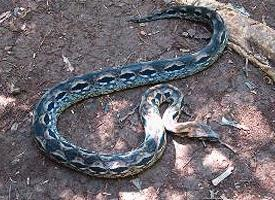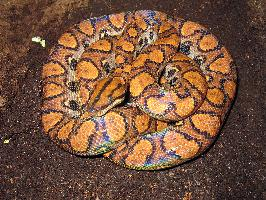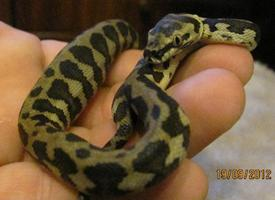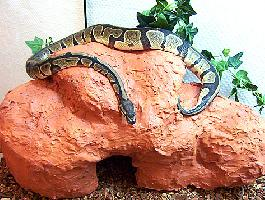
Váhy a míry
| Délka | 3 m |
|---|
Biologická data
| Délka březosti | od 4 do 8 m |
|---|---|
| Počet mláďat | 4 - 6 |
Popis zvířete
The Madagascar ground boa (Acrantophis madagascariensis) is a captivating species of non-venomous snake endemic to the island of Madagascar, a biodiversity hotspot off the southeast coast of Africa. This remarkable reptile is one of the island's largest snakes, showcasing the unique evolutionary paths that species can take in isolated environments.Physical Characteristics:
The Madagascar ground boa exhibits a robust and muscular body, with adult individuals typically reaching lengths of 6 to 8 feet (1.8 to 2.4 meters), though some specimens have been reported to exceed these dimensions. Their skin is adorned with a striking pattern that serves as camouflage within their natural habitat. The base coloration of these snakes can vary from reddish-brown to gray, overlaid with darker patches or bands. This patterning not only helps them blend into the forest floor but also accentuates their formidable presence. Their scales are smooth, contributing to their sleek appearance, and their eyes have a captivating look, with vertical pupils that hint at their crepuscular to nocturnal nature.
Habitat and Distribution:
As an endemic species, the Madagascar ground boa is found exclusively in Madagascar. Its preferred habitats include dry deciduous forests, spiny forests, and occasionally the more humid areas of the island. These snakes are ground-dwelling, though they are also adept climbers when the situation necessitates, such as for hunting or escaping potential threats. Their distribution across the island is patchy, influenced by environmental conditions and human activities that threaten their habitats.
Diet and Hunting Behavior:
Madagascar ground boas are constrictors, employing their powerful bodies to subdue prey. Their diet primarily consists of small to medium-sized mammals, birds, and possibly reptiles. They are ambush predators, relying on their camouflage to remain undetected until an unsuspecting prey comes within striking distance. Once captured, the prey is quickly wrapped in the boa's coils, and the constricting pressure leads to suffocation. These snakes have a slow metabolism, which means they can survive on relatively few, but substantial, meals throughout the year.
Reproduction:
The Madagascar ground boa is ovoviviparous, meaning the females give birth to live young. This reproductive strategy is relatively rare among snakes and offers the newborns a higher survival rate by providing protection during development. Females are known to give birth to litters of up to a dozen or more young, which are independent from birth and receive no parental care. The neonates are miniature versions of the adults, equipped with the same cryptic patterning and hunting instincts.
Conservation Status:
The Madagascar ground boa is classified as Vulnerable by the International Union for Conservation of Nature (IUCN). The species faces numerous threats, including habitat loss due to deforestation, agricultural expansion, and human settlement. Additionally, these snakes are sometimes killed out of fear or for their skin. Conservation efforts are crucial to ensure the survival of this species, requiring habitat protection, research, and community-based initiatives to mitigate human-wildlife conflict.
In summary, the Madagascar ground boa is a fascinating and significant part of Madagascar's unique biodiversity. Its existence underscores the importance of conservation efforts to protect the island's endemic species and their habitats, which are under increasing pressure from human activities.
Podobná zvířata
Nové fotografie zvířat
Top 10 zvířat
- Chinese water dragon (Physignathus cocincinus)
- Galápagos tortoise (Geochelone nigra complex)
- Dolphin gull (Leucophaeus scoresbii)
- Japanese macaque (Macaca fuscata)
- Colombian red howler (Alouatta seniculus)
- Sea urchins (Echinoidea)
- Moustached guenon (Cercopithecus cephus)
- Diana monkey (Cercopithecus diana)
- Common reed warbler (Acrocephalus scirpaceus)
- Common house mosquito (Culex pipiens)


